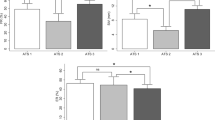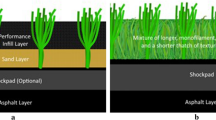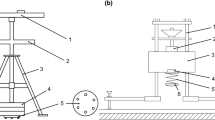Abstract
Artificial turf is a widespread surface used for various field sports, offering unique advantages to natural grass such as all-weather availability and durability. This study aimed to determine the influence of infill depth and the exposed fibre height on shoe–surface traction for artificial turf surfaces. Particular focus was placed upon rotational traction, which has been associated with lower extremity injuries in sports. Ten artificial turf surfaces with varying infill depth and exposed fibre length were mechanically tested, with results indicating a significant impact of infill depth on rotational traction (F = 3.150, p = 0.017, \({\eta }^{2}\) = 0.104); as infill depth increased, a reduction in rotational traction was observed. For surfaces with longer carpet fibres, a trend to a significant correlation between exposed carpet fibre length and rotational traction was also observed (R2 = 0.7236, p = 0.068). Exposed fibre lengths above 18–20 mm were associated with an increase in rotational traction. Results suggest that at around 12–18 mm, any further reduction in exposed fibre length may have little to no influence on rotational traction. These findings have implications for player safety, aligning with prior research linking excessive rotational traction to elevated injury risks and highlight the importance of maintaining prescribed infill depths and exposed fibre lengths on artificial turf surfaces.





Similar content being viewed by others
References
Fleming P (2011) Artificial turf systems for sport surfaces: current knowledge and research needs. Proc Institut Mechan Eng Part P J Sports Eng Technol 225(2):43–64. https://doi.org/10.1177/1754337111401688
Burillo P et al (2012) Mechanical assessment of artificial turf football pitches: the consequences of no quality certification. Scient Res Essays. https://doi.org/10.5897/sre11.1454
Zanetti EM, Bignardi C, Franceschini G, Audenino AL (2013) Amateur football pitches: Mechanical properties of the natural ground and of different artificial turf infills and their biomechanical implications. J Sports Sci 31(7):767–778. https://doi.org/10.1080/02640414.2012.750005
Wannop JW, Foreman T, Madden R, Stefanyshyn D (2019) Influence of the composition of artificial turf on rotational traction and athlete biomechanics. J Sports Sci 37(16):1849–1856. https://doi.org/10.1080/02640414.2019.1598923
Wannop J, Kowalchuk S, Esposito M, Stefanyshyn D (2020) Influence of artificial turf surface stiffness on athlete performance. Life 10(12):340. https://doi.org/10.3390/life10120340
Wannop JW, Luo G, Stefanyshyn DJ (2013) Footwear traction and lower extremity noncontact injury. Med Sci Sports Exerc 45(11):2137–2143. https://doi.org/10.1249/MSS.0b013e318299ac56
McGhie D, Ettema G (2013) Biomechanical analysis of traction at the shoe-surface interface on third-generation artificial turf. Sports Eng 16(2):71–80. https://doi.org/10.1007/s12283-013-0115-1
Wannop JW, Stefanyshyn DJ (2016) The effect of translational and rotational traction on lower extremity joint loading. J Sports Sci 34(7):613–620. https://doi.org/10.1080/02640414.2015.1066023
Severn KA, Fleming PR, Clarke JD, Carre MJ (2011) Science of synthetic turf surfaces: Investigating traction behaviour. Proc Instit Mech Eng Part P J Sports Eng Technol 225(3):147–158. https://doi.org/10.1177/1754337111408980
Sánchez-Sánchez J, García-Unanue J, Gallardo AM, Gallardo L, Hexaire P, Felipe JL (2018) Effect of structural components, mechanical wear and environmental conditions on the player–surface interaction on artificial turf football pitches. Mater Des 140:172–178. https://doi.org/10.1016/j.matdes.2017.11.066
Dickson K, Sorochan J, Strunk W (2020) Impact of alternative synthetic turf infills on athlete performance and safety. 13th Conference of the International Sports Engineering Association. https://doi.org/10.3390/proceedings2020049035
Jastifer J et al (2022) The development of mandatory practices for the testing and maintenance of synthetic turf fields in the National Football League. Int Turfgrass Soc Res J 14(1):352–363. https://doi.org/10.1002/its2.94
Kent R et al (2015) The mechanical interactions between an American football cleat and playing surfaces in-situ at loads and rates generated by elite athletes: a comparison of playing surfaces. Sports Biomech 14(1):1–17. https://doi.org/10.1080/14763141.2015.1024277
Tay SP, Fleming P, Hu X, Forrester S (2017) Skin friction related behaviour of artificial turf systems. J Sports Sci 35(15):1500–1507. https://doi.org/10.1080/02640414.2016.1223330
Forrester S, Fleming P (2019) Traction forces generated during studded boot-surface interactions on third-generation artificial turf: a novel mechanistic perspective. Engineering Reports, In Proceedings of the 13th Conference of the International Sports Engineering Association. 49(35). https://doi.org/10.1002/eng2.12066
Severn KA (2010) Science of synthetic turf surfaces: player-surface interactions. Loughborough University. Thesis. https://hdl.handle.net/2134/7216
Sujae IH, Abdul Jabbar K, Ong CY, Hamill J (2022) Differences in joint loading during a side-step cutting manoeuvre on different artificial turf infill depths. Sports Biomech 21(9):981–992. https://doi.org/10.1080/14763141.2020.1713206
Jastifer JR, McNitt AS, Mack CD, Kent RW, McCullough KA, Coughlin MJ, Anderson RB (2019) Synthetic turf: History, design, maintenance, and athlete safety. Sports Health 11(1):84–90. https://doi.org/10.1177/1941738118793378
Dickson KH, Straw CM, Thoms AW, Carson TD, Sorochan JC (2022) Impact of third generation synthetic turf athletic field age on surface hardness and infill depth spatial variability. Proc Instit Mech Eng Part P J Sports Eng Technol 236(3):192–199. https://doi.org/10.1177/17543371211002947
Meyers MC (2019) Incidence, mechanisms, and severity of game-related high school football injuries across artificial turf systems of various infill weights. Orthopaedic J Sports Med. https://doi.org/10.1177/2325967119832878
McGowan H et al (2023) Understanding the variability in rotational traction testing on artificial turf. Sports Eng. https://doi.org/10.1007/s12283-023-00426-4
Funding
This research was funded by the Natural Science and Engineering Research Council of Canada (NSERC) and by FieldTurf—grant number CRDPJ 533859–18.
Author information
Authors and Affiliations
Corresponding authors
Ethics declarations
Conflict of interest
The authors declare that they have no conflicts of interest. Although this project was partially funded by FieldTurf, FieldTurf was not involved in data collection or in the interpretation of the results.
Additional information
Publisher's Note
Springer Nature remains neutral with regard to jurisdictional claims in published maps and institutional affiliations.
Rights and permissions
Springer Nature or its licensor (e.g. a society or other partner) holds exclusive rights to this article under a publishing agreement with the author(s) or other rightsholder(s); author self-archiving of the accepted manuscript version of this article is solely governed by the terms of such publishing agreement and applicable law.
About this article
Cite this article
Ruschkowski, J., Varughese, J.M., Stefanyshyn, D.J. et al. Influence of infill depth and fibre height of artificial turf on rotational traction. Sports Eng 27, 13 (2024). https://doi.org/10.1007/s12283-024-00455-7
Accepted:
Published:
DOI: https://doi.org/10.1007/s12283-024-00455-7




